This week, I’d like to discuss one of the more exciting, as well as intimidating, areas of the design of Forged of Blood: Magurite, our system of magic. As someone that is a bit particular about details, I wanted the magic to make sense for the world in which it was meant to exist. This meant defining the source of energy, the limitations of what the magic could do, and how it impacts the culture; these would inherently restrict how it could be designed. At the start, we set out to nail down all of these. For this, we pulled heavily from our discussions on Brandon Sanderson’s work.
I first discovered Sanderson when he completed Robert Jordan’s masterpiece The Wheel of Time. Having thoroughly enjoying his contribution, I moved on to his other works, such as the Mistborn series and the Stormlight Archive. What I so thoroughly enjoy about his work is the world’s he creates. It is not the typical fantasy system of medieval europe + archaic magic. Instead, it is a clearly defined system of magic that was fully integrated into the world. Sanderson has many blogs about the creation of a good system of magic, such as this one: http://brandonsanderson.com/sandersons-first-law/.

Guided in spirit by my appreciation of Sanderson’s work, we set out to create a world in which magic existed not only superficially but was integrated reasonably within the world it exists. Our magic stems from Magurite, a resource harvested from large bestial inter-dimensional creatures called Bracati; the larger the Bracati, the more powerful the Magurite. However, the Magurite is not the actual source of energy for the spells. Instead, the Magurite allows the wielder to pull, or Drain, an element, known as a Primordial, from an area and then release, or Expel, the Primordial in another area. Probably the easiest Primordial to visualize is the Thermal Magurite. A Thermal Magurite’s Base Effect pulls in heat from a targeted area, causing cold damage to Target’s in that area. After draining heat, the Thermal Magurite is full and can not drain any more without releasing the heat at another targeted area, causing heat damage. Magurite can effectively hold 2 Charges before it is full, allowing for 3 states that we call Positive, Negative and Neutral. There are 3 types of discovered Primordial: Thermal, Arcane and Spirit. These combined with Drain and Expel Charges create the 6 Primordial Energies: Thermal Expel, Thermal Drain, Arcane Expel, Arcane Drain, Spirit Expel, and Spirit Drain.


Once the conceptual system of magic was set, the creation of spells and advancement in magic needed to be developed. As a fan of the fantasy genre since I read the Sword of Shannara in 4th grade, I have always liked the idea of having the freedom to wield magic as I read in books and we set out to create a system granting as close to that level of freedom as we believed we could. Some limitations were necessary given our advancement system and need to implement a consistent and coherent mechanic. Each Spell Effect needed to be progressive: 1 point must be different than 2 points. The Spell Effect needs to be able to be applied to the 6 Primordial Energies. The Spell Effect must also fit within the lore of the game, which meant long range teleportation, resurrection, time travel, and other extreme powers were precluded due to the degree that they would alter the world. After a few discussions delineating what we could not do, I set out on defining what we could do.
When I visualize the creation of spells, there are really different components to it and we tried to break those components down into specific mechanics. When visualizing it, we can change the shape, size, and duration of the spell; we can change the effect that the spell has; we can change the power of the spell. To help find inspiration, we looked at a lot of different spells from table top games and some of my favourite RPGs, making a list of spell outcomes that would be nice to be able to create with our spell system and then broke those spells down to their individual attributes, the effect, shape, and other clearly identifiable mechanics. We then created a system to allow these attributes to be combined to create new and unique spells. However, the attributes needed to be universally viable, which precluded attributes that did not combine adequately with all other attributes. Everything needed to be scalable by shape, size, power, and a plethora of other limiting factors. This lead to an intuitive mechanical process for the creation of Spells and a list of criteria for additions to the system.

In the final Spell Creation system, the player first selects the Primordial Energy, effectively determining the general type of spell that will be cast. Then the player can select up to five, out of ten, distinct Spell Effects that the spell will apply; all spells must have at least 1 Spell Effect. The player can then modify the spell in general by applying Global Modifiers, such as Width to increase the area of effect or Duration to cause the spell to last longer, or Effect Modifiers, such as Follow to cause the Effect to stick to affected targets and Selective to preclude specific targets. The Effects and Modifiers will be applied in the order in which they appear in the spell; while most of the time this distinction is trivial, in some instances, it can make a significantly different outcome. Finally, Spells are cast at areas rather than at targets; targets in the area can be affected by the Spell’s Effects and Modifiers.
After establishing the Spell Creation system, some desired Effects and Modifiers still didn’t quite appear naturally, so specialized combined Effects and Modifiers were developed. For instance, if you use a Thermal Drain Base Effect with a high enough Effect Power modified by Width and Duration, a Wall of Ice will be created in the targeted area with HP that scale to the Effect Power of the Thermal Drain Base Effect. Because of the incalculable permutations of spells, I believe that our magic system will have lots of uses beyond what we have originally envisioned. However, I will give an example of some of the ways in which it can be combined to have different effects.

In the Spell Creation UI GIF above, you can see a player selecting the Thermal Expel Primordial Energy and then applying the Base Effect. The player then increases the Effect Power of the Base Effect with an Effect Modifier and then increases the Width and Length of the spell with Global Modifiers; Width and Length Global Modifiers combine to create a more circular Area of Effect. In the GIF preceding this paragraph, you can see an isolated example of a character casting a single target Thermal Expel with an unmodified Base Effect. For the more observant, you may have noticed that the sigil of the spell matches the Effects and Modifiers of that spell.
Spirit Expel has a Base Effect that heals affected targets. By applying the Duration ability, you would be able to create an area that would heal anyone entering the square for the duration of the spell and healing anyone in the square at the start of the Caster’s turn. Placed behind your units, your units could move through it during their turns for a quick heal; you would need to be careful as the opposing forces could also pass through the square for a quick heal. By applying the Follow Effect Modifier and the Duration Effect modifier, you would cause a Heal over Time effect that follows the affected character, basically regeneration.
One of the more interesting Effects to play with is Xeno. The Xeno Effect applied to an Arcane Expel Spell will cause the targets to teleport to a selected area. While this could be used to teleport units to desired locations within the range of the spell, adding specific Modifiers or other Effects allows for more creative uses of the effect. For instance, if you were to add the Global Modifiers Length and Width and the Base Effect after the Xeno Effect, the spell would teleport targets to an area and then deal Area of Effect damage from the new Area. A variation I enjoy using is the Xeno Effect with the Follow and Duration Modifiers; this would cause the affected target to be Teleported to the designated location at the start of the Caster’s turn for the duration of the spell, effectively trapping the character to a specific area of the map until they manage to escape the range of the spell, the spell is countered, or the spell runs its course.
After coming up with the system itself, next came the implementation of the system. While I did not see any inherent reason why it couldn’t be implemented, I had strong reservations that there would be technical concerns that I hadn’t thought of. However, our programmers implemented an entirely functional first pass of the system without any serious hiccups. We still need to do a lot of testing, reiteration, balance passes, and visual integrations but the system of magic itself is mechanically functional. There will still be the immense challenge of creating an AI dynamic enough to handle the countless situations that may arise and the full integration of all aspects of the spell system into the rest of the game. Despite the challenges to come, I am confident that Forged of Blood will have a more dynamic system of magic than any I have encountered during my decades of gaming.


Looks like a fun and engaging system! Will this be an isometric rpg?
Yup! Forged of Blood is a Turn-based Tactical RPG, mostly centered around the tactical combat, but as you can see we’ve really put a lot of time into opening up how players can build their characters.